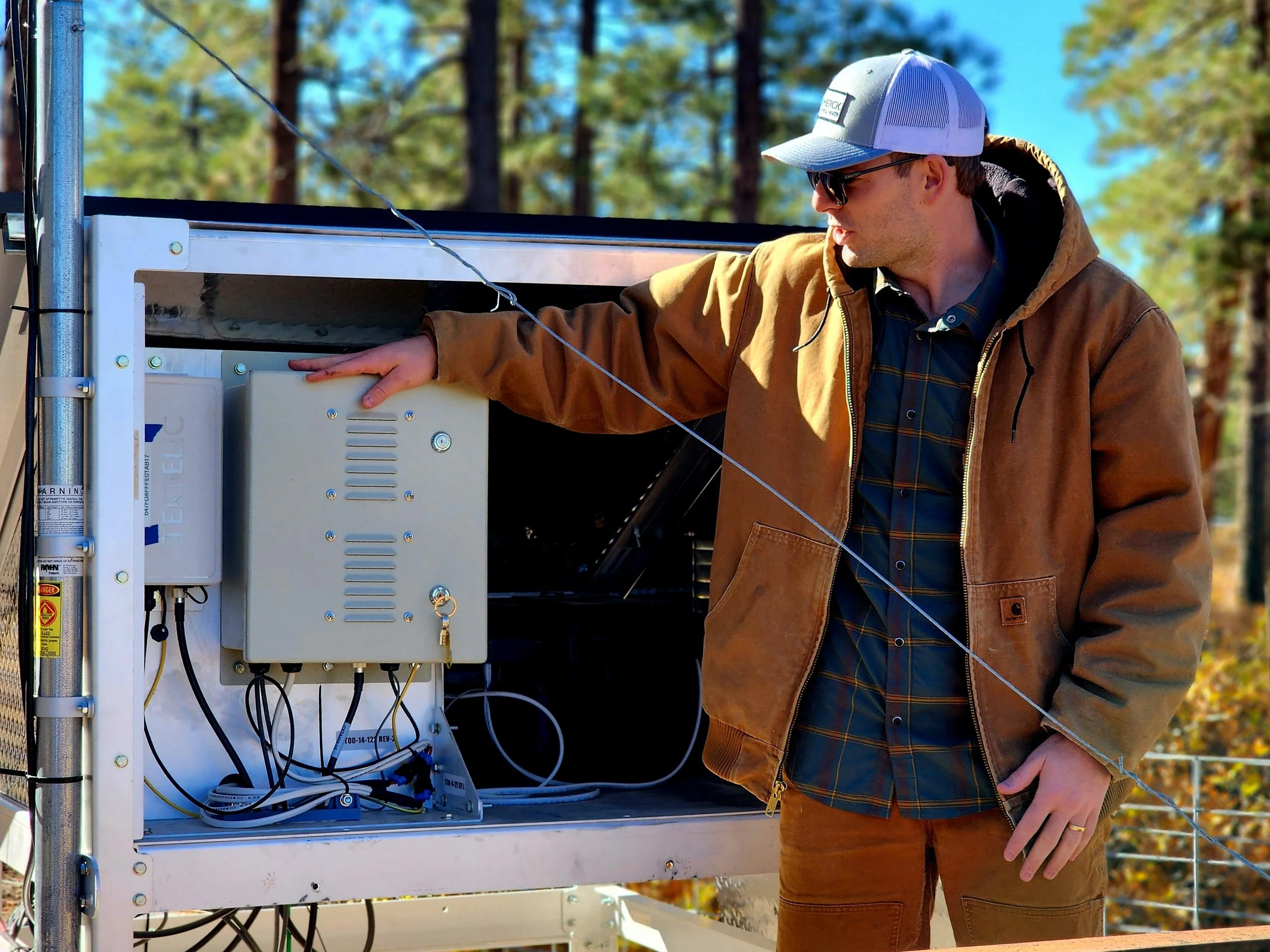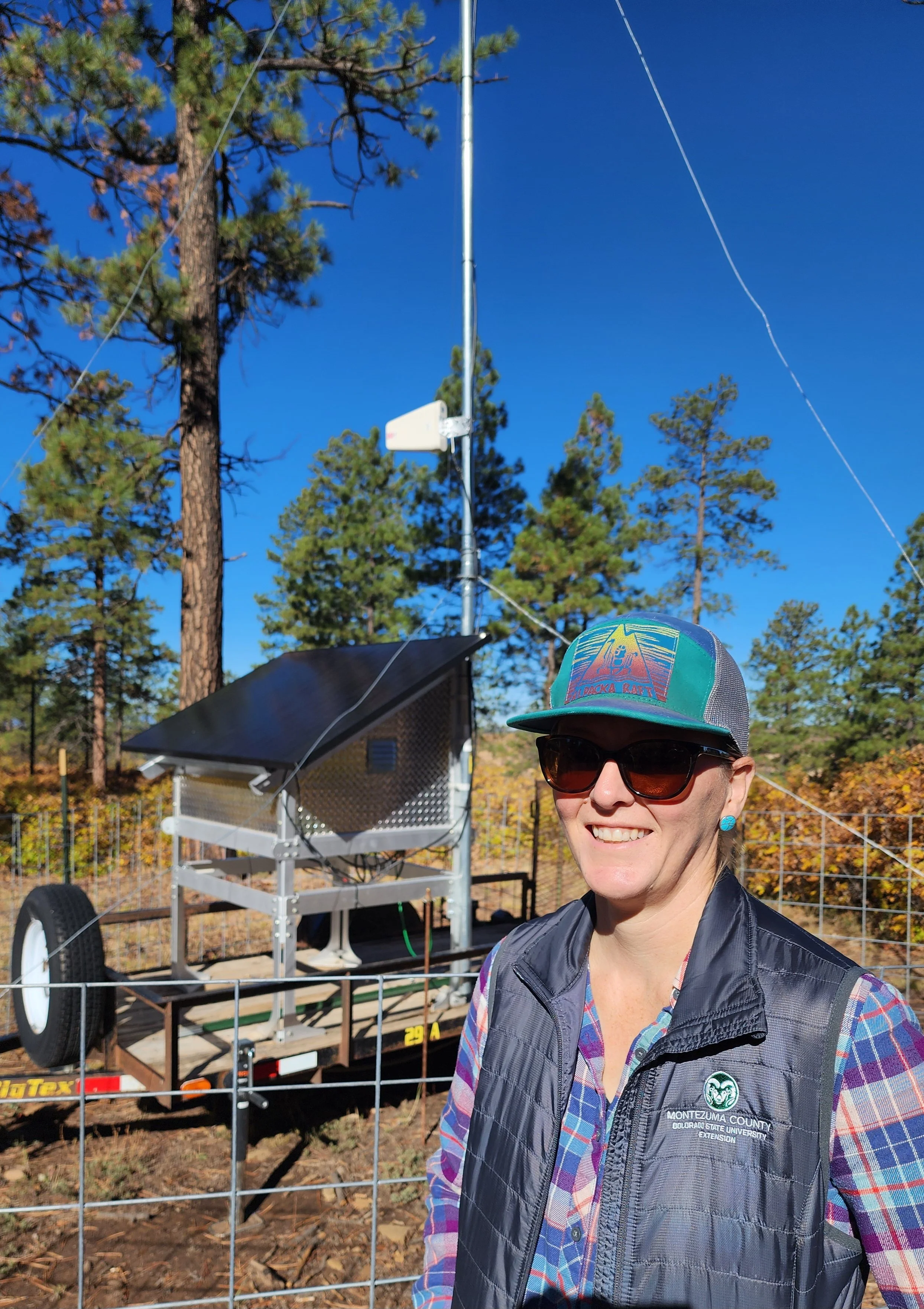Virtual fence technology improves grazing management on public lands
2024/10/23 | Colorado: Montezuma and Dolores Co.
Virtual fence technology improves grazing management on public lands
Virtual fence field day with Vence Virtual Fence and local ranchers on the San Juan National Forest
By Matt Barnes
A couple dozen ranchers, virtual fence company employees, and agency rangeland specialists from the U.S. Forest Service and the Bureau of Land Management, as well as from the Natural Resources Conservation Service and Colorado State University Extension, gathered on a brisk fall morning to learn about virtual fence, which might be the most significant technological innovation for improving grazing management on the range in the last century. We travelled through ponderosa pine, Gambel oak, and grass meadows to see how it is being used on a grazing allotment on the San Juan National Forest.
Previously, along with CSU Extension and the Forest Service, I did some monitoring in this area, and that monitoring showed mostly good rangeland health, and some modest impact of grazing near water sources and little if any impact on the rest of the landscape.
Most problems with livestock grazing on rangelands in the western U.S. are distribution problems: preferred areas and plants are repeatedly grazed while others are ignored. Strategic grazing management is all about managing the distribution of grazing across space, time, and plant communities, so that solar energy can be cycled through grass and grazing animals (both domestic and wild), while preventing overuse of those preferred areas and plants. [1] But how do you do it? Traditionally, with cross-fences and various grazing management “systems” involving deferment, rest, and grazing periods rotated around the landscape. Many national forest grazing allotments use a combination of rest rotation and rotational grazing. Ideally, the grazing is planned and managed such that all forage plants are grazed once and then given time to recover. [2] The reality is always more complex [3], but strategic grazing can improve distribution on large and mountainous landscapes. [4,5,6]
Fences and water developments have changed the face of the western landscape, beginning with those two inventions that made ranching as we know it possible: barbed wire and windmills. In recent decades, electric fence—both permanent and temporary—has made it possible to manage grazing more intensively. For example, on the ranch I managed for a few years, we used a combination of existing “permanent” barbed wire fence, “permanent” high-tensile electric fence, and temporary polywire electric fence to implement holistically planned strategic grazing and to redistribute the grazing from riparian areas to uplands, including steep mountain slopes. [6] The phrase “permanent fence” might be an oxymoron, as, especially in the mountains, time, snow, and wildlife all take their toll, and every mile of fence needs to be maintained every year, or it deteriorates into something that cattle find their way through, but wildlife can still get hung up in.
Enter virtual fence. Fencelines you program into a computer. Put them wherever you want. Turn them on and off. Move them. Suddenly, strategic grazing management is infinitely more feasible. I’d say that’s the greatest technology for grazing management since barbed wire, and it’s a whole lot more friendly to the rest of the landscape, especially the wildlife.
The technology involves base stations, collars, and your computer. The base stations transmit the fencelines to the collars on the cattle, and the collars transmit the animals’ locations back to the base stations and ultimately to your computer screen. You can see your cows on the map—not just their most recent location, but also where they were yesterday, last week, etc. And adjust accordingly. Most operations, at least in the mountainous West, have three or four base stations, and collar every cow and every bull. Generally, the towers are purchased and owned by the ranch or ranches (it could be an association or even a conservation district); the collars are leased from the company on an annual basis.
The technology was originally developed by range scientist Dean Anderson of the USDA Agricultural Research Service, at the Jornada Experimental Range. After Anderson showed proof of concept, it was left to the market. In recent years, a few companies like Vence, now a part of Merck Animal Health, have made it commercially available. You can learn more about how the technology facilitates range management from Anderson on The Cornerstones of Healthy Food Systems podcast.
In the big picture, west-wide, grazing management is getting better. Rangelands are slowly recovering from historic overuse, much of which happened in the wake of the frontier era, before range management was even in the lexicon. There will always be room for improvement, but in many ways our public lands are the world’s great success story.
Some days that looks like a rancher, a tech company, and a government agency showing off how they are using the latest technology to make things better.
References
Barnes and Hild [eds.]. 2013. Strategic Grazing Management for Complex Creative Systems [special issue]. Rangelands 35(5): 1-66.
T. Steffens, G. Grissom, M. Barnes, F. Provenza, and R. Roath. 2013. Adaptive grazing management for recovery: Know why you’re moving from paddock to paddock. Rangelands 35(5): 28-34.
F. Provenza, H. Pringle, D. Revell, N. Bray, C. Hines, R. Teague, T. Steffens, and M. Barnes. 2013. Complex creative systems: Principles, processes, and practices of transformation. Rangelands 35(5): 6-13.
M.K. Barnes, B.E. Norton, M. Maeno, and J.C. Malechek. 2008. Paddock size and stocking density affect spatial heterogeneity of grazing. Rangeland Ecology & Management 61(4): 380-388.
B.E. Norton, M. Barnes, and R. Teague. 2013. Grazing management can improve livestock distribution: Increasing accessible forage and effective grazing capacity. Rangelands 35(5): 45-51.
M. Barnes and J. Howell. 2013. Multiple-paddock grazing distributes utilization across heterogeneous mountain landscapes. Rangelands 35(5): 52-61.






